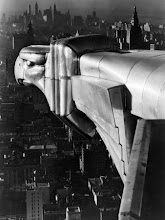Writer Marie-Hélene Huet draws from Aristotelian theory to suggest “The monster and the woman…find themselves on the same side, the side of dissimilarity .” Just as, she says, demons are engendered due to the power of a mother’s imagination during pregnancy, usurping the place of the father as progenitor , Eve as well is deformed when she is birthed from Adam’s body. Namely, she is dissimilar from man. She is not, however, dubbed a “demon” as Lilith was, in spite of the fact that Lilith was not the distorted offspring of a human.
Perhaps because of this conflation, women in Abrahamic religions are disvalued and their importance underplayed. In Judeo-Christian tradition, some important women such as Yael, killer of Sisera , and Delilah, the temptress and lover of Samson , are noted, but they are seen in a negative light. In Muslim tradition, women are severely undermined, with only one appearing in the Koran: the Virgin Mary . Mary is, without doubt, the most important woman in Abrahamic tradition, and the one viewed most positive among followers, albeit because she birthed Jesus, and as a character is strengthened from her similarities to the Lord.
The Hours of Catherine of Cleves, an illuminated manuscript lavishly decorated with scenes from Christian history, displays the intrinsic prominence of demonic imagery in the religion, and the correlations it draws between demons and women. In the Office of the Blessed Virgin Mary, demons encroach on the territories of the celebration of the Virgin’s story, disrupting the life of a woman with misogynistic undertones. In “Joachim and Anne Meeting at the Golden Gate,” depicting the discovery of Anne’s pregnancy with Mary, the marginalia are strife with demons: a blue dragon with a golden orb in its mouth, and a green goblin playing two pipes. In “God Dispatching the Archangel Gabriel,” a creature resembling an amalgamation of eagle, monkey and reptile settles itself onto the bottom of the page. And in the plate illustrating the Annunciation (Fig. 1), above the angel Gabriel and the Virgin Mary is the head of an orange demon in the archway, grimacing, holding two golden orbs in its claws. The event, a popular subject of Christian painting and an important story in the Bible, is disturbed by the presence of this figure.
 Fig. 1 Master of Catherine of Cleves, Annunciation (Detail) from the Hours of Catherine of Cleves, ca. 1440. 7 1/2 x 5 1/8 inches. Morgan Library and Museum, New York City.
Fig. 1 Master of Catherine of Cleves, Annunciation (Detail) from the Hours of Catherine of Cleves, ca. 1440. 7 1/2 x 5 1/8 inches. Morgan Library and Museum, New York City.Further into the Hours, in the Office of the Dead, the representation of Purgatory shows enfeebled bodies with the stout anatomy and fatty curves typically associated with children being devoured by flames in a leonine demon’s mouth. This purging of sin is a necessary step before entering the Kingdom of Heaven, and the chthonic imagery used to depict this realm clearly creates a comparison to Hell.
As in the plate depicting Purgatory, Hell is similarly rendered as a demonic mouth devouring souls (Fig. 2). However, in this image, the mouth is much grander, and more sinister, and a legion of demons is seen torturing the souls on their journey into the underworld. The ghoulish servants of Satan drive a black chariot, packed with humans, into the fiery maw. In both plates, the sensuous, undulating contours and sumptuous colors of the mouths of the beasts are decidedly vulvar in their execution. This picture of Hell once again links woman and demon in the Hours of Catherine of Cleves.
 Fig. 2 Master of Catherine of Cleves, Mouth of Hell (Detail) from the Hours of Catherine of Cleves, ca. 1440. 7 1/2 x 5 1/8 inches. Morgan Library and Museum, New York City.
Fig. 2 Master of Catherine of Cleves, Mouth of Hell (Detail) from the Hours of Catherine of Cleves, ca. 1440. 7 1/2 x 5 1/8 inches. Morgan Library and Museum, New York City.The gruesome and demonic imagery present in the Bible as well as prayer books such as the Hours of Catherine of Cleves reinforces the idea that humans are subject to the will of higher forces, particularly women. Huet continues in her uncovering of the monstrous imagination by examining the etymology of the word “monster,” deciding it stems from the Latin monstrare meaning “to show, to display.” She concedes, “this tradition confirmed the idea that monsters were signs sent by God, messages showing his will or his wrath… ” Demonic imagery acts as a reminder to faithful Christians of the dangers of sin and the dissidence of God’s word. This idea stems from the story of Original Sin, in which Eve plights humanity for her disobedience to God’s strictures, cementing the connection of the woman and the demon.
People whose ideas I stole:
1. Mark 3:22
2. Isaiah 27:1
3. Isaiah 34:14
4. Genesis 1:27
5. “The Story of Lilith,” JewishChristianLit.com, http://jewishchristianlit.com//Topics/Lilith/alphabet.html
6. Marie-Hélene Huet, Monstrous Imagination (Harvard University Press, 1993), 85.
7. Ibid.
8. Judges 5:23-27
9. Judges 16
10. “Qur'anic verses - The Birth of Mary,” Koran.Topcities.com, http://koran.topcities.com/Mary(3,35-37).htm
11. Marie-Hélene Huet, Monstrous Imagination (Harvard University Press, 1993), 87.


1 comment:
You should take a class by Mark Goldblatt. If not, let me steal your papers for his class
Post a Comment